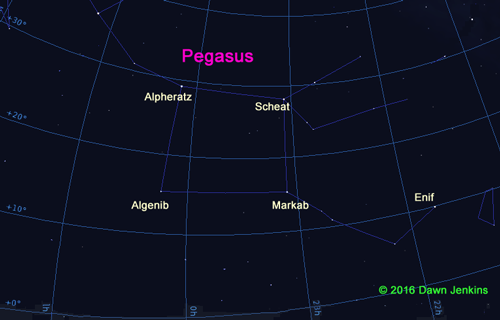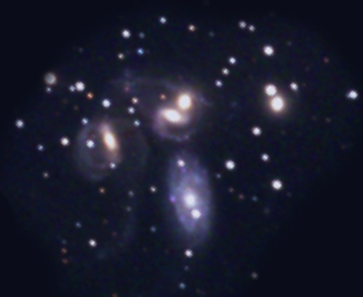
October 2016 - Vol. 20, No. 10
This Month's Night Sky - NOTE: The next paragraph describes the sky as it appears at 10 pm EST (11 pm EDT) near mid- month. The sky also looks this way at 11 pm EST (midnight EDT) during the beginning of the month and at 9 pm EST (10 pm EDT) by month's end.
Although the Summer Triangle is still visible in the W, the Square of Pegasus is now prominent high in the S. Far below, lonely Fomalhaut [FOE-ma-lot] of Piscis Austrinus still glitters near the S horizon. Between Pegasus and the N pole star, Polaris (Ursa Minor), find the familiar "W" shaped asterism of Cassiopeia. If you are fortunate to be viewing from a dark site, you will also see the constellations, Perseus and Auriga, with its bright star, Capella, embedded in a starry band stretching across the night sky from E to W. You are looking at the Milky Way, one of the spiral arms of our galaxy. In the E the constellations, Gemini, with its bright twin stars, Castor and Pollux, and Orion, with its distinctive hour glass asterism, rise above the E horizon. Now the Big Dipper (Ursa Major) dips low in the N.
MERCURY is well placed for the morning twilight sky the first half of themonth, most favorable to northern observers.. VENUS continues shining in the evening sky, meets up with Saturn on the 30th. MARS sets in the early evening, in the constellation Sagittarius. JUPITER is visible in morning twilight. SATURN sets in the evening. URANUS reaches opposition on October 15. The outer planet NEPTUNE in the constellation of Aquarius will be visible most of night for telescopic observations.
Review how to determine Angular Measurement.
Calendar of Events
NOTE: For those observers not in the ET zone, convert the calendar times to your zone's time by subtracting one hour for CT, two for MT and three for PT. Don't forget to adjust for Daylight Savings Time when necessary by subtracting one hour from your planisphere's time. Dawn and dusk times must also be corrected. See your local newspaper, TV news, or cable TV's Weather Channel for sunrise and sunset times or check with the U.S. Naval observatory. Unfortunately some of these events may occur during daylight hours in your area.
| DATE | EVENT |
| 03 | Venus 5 deg S. of Moon. |
| 04 | Moon at apogee. |
| 08 | Draconic meteors peak, this is a minor shower. |
| 11 | Mecury and Jupiter meet in a daytime conjunction, not visible. |
| 13 | Neptune 1.2 deg S. of the Moon, occultation observable from eastern Russia, Alaska, and northwestern Canada. |
| 15 | Uranus at opposition. |
| 17 | Moon at perigee, expect large tides until October 20. |
| 19 | Aldebaran 0.3 deg S. of the Moon occultation from Mexico, Cental America. |
| 21 | Orionid meteors peak, this storm generates up to 20 meteors per hour. This shower is associated with the famous Halley's Comet. |
| 25 | Regulus 1.6 deg N. of Moon. |
| 27 | Mercury in superior conjuntion. |
| 28 | Jupiter 1.4 S of Moon. |
| 29 | Mars at perihelion. |
| 30 | Saturn 3 deg N. of Venus, in a group with the first magnitude star Antares. |
| 31 | Moon at apogee. |
Lunar Almanac for October 2016
| Phases of the Moon | Phase and Date(s) | Best viewed before local midnight |
 |
New 01 |
Deep Space Objects |
 |
1st. Qtr 09 |
Planets & Moon |
 |
Full 16 |
Moon |
 |
Last Qtr 22 |
Deep Space & Planets |
Topic of the month: The Winged Horse, Pegasus
The evening sky welcomes the northern hemisphere to longer nights and views of the celestial vault, while in the south night is shrinking and Spring has arrived. Soon after darkness falls, the great square of Pegasus is now fully risen above the eastern horizon. An ancient constellation fairly easily recognized as four stars trace out the shape of a square. These are Markab, Sheat, Algenib and a fourth star, officially attributed to the adjoining constellation of Andromeda, the star Alpheratz. This "great square" has been a valuable guide for navigators and astronomer's alike. Another prominent star in the constellation is the Epsilan Pegasi, Enif that is said to represent the "nose" of the horse. Pegasus, like many other constellations, only represents the front half of the horse including the wings. Pegasus is also notable as it lies on the 0 hour of right ascension. Each side of the square covers 15 deg of the sky, lying in a north-south direction.

Two stars, Alpheratz and Algenib point to the position of Spring equinox, the position of the Sun on the first day of Spring, about as far below them as the distance of their separation.There is no special star to mark this position, but it may help to understand how the stars appear to rotate around the Earth on the celestial sphere. Markab is considered to be the alpha star of the constellation, its magnitude is 2.5, consequently there are no first magnitude stars in the constellation. The star 1 Peg at magnitude 4.1 is a nice double, a yellow star with a mag 9 companion visible in small telescopes.
There are some wonderful objects in the constellation of Pegasus, including the bright globular cluster M-15. It is one of the most beautiful clusters in the northern sky, about 4 deg N. of Enif. The core of this cluster is very bright, occupied by a host of13th magnitude stars, that may be seen in a larger instrument at 175x. Another favorite galaxy in the constellation is NGC 7331, a 10th magnitude spiral galaxy about 40 million light years away. This galaxy is often used to illustrate how the Milky Way would appear from a distance. It is a type Sb spiral, tipped about 20 degrees toward us. It has 4 known companion galaxies that also have NGC numbers.
 Not far from NGC 7331 is a group of interacting galaxies known as Stephan's Quintet. Only four of these are actually interacting, NGC 7320 is actuallly in the foreground and does not interact as the others do. The image of the quintet on this webpage was taken from Stellarium planetarium software "zoomed in" on the galaxies, to demonstrate how complete the software is and what kind of images can be found deep inside. The main group of interacting galaxies are located about 280 million light years from Earth while the foreground galaxy is a mere 39 million light years away. These galaxies have had multiple collisions and tails streaming between individual members can be seen. The galaxies emit x-rays and molecular hydrogen causes infrared radiation as well. This compact group is most likely the most studied group of interacting galaxies. A small telescope will resolve only the brightest galaxy, the nearby 7320 as a small blob of light, but high resolution images will reveal many individual, bright new stars and the tails arcing between the interacting members. Another view of Stephan's Quintet can be found at Astronomy Pictue of the Day (APOD), with additional explanations.
Not far from NGC 7331 is a group of interacting galaxies known as Stephan's Quintet. Only four of these are actually interacting, NGC 7320 is actuallly in the foreground and does not interact as the others do. The image of the quintet on this webpage was taken from Stellarium planetarium software "zoomed in" on the galaxies, to demonstrate how complete the software is and what kind of images can be found deep inside. The main group of interacting galaxies are located about 280 million light years from Earth while the foreground galaxy is a mere 39 million light years away. These galaxies have had multiple collisions and tails streaming between individual members can be seen. The galaxies emit x-rays and molecular hydrogen causes infrared radiation as well. This compact group is most likely the most studied group of interacting galaxies. A small telescope will resolve only the brightest galaxy, the nearby 7320 as a small blob of light, but high resolution images will reveal many individual, bright new stars and the tails arcing between the interacting members. Another view of Stephan's Quintet can be found at Astronomy Pictue of the Day (APOD), with additional explanations.
The Great Square of Pegasus is also used to find the closest large galaxy to the Milky Way in the nearby Andromeda constellation. The spiral galaxy M-31 is so bright that it can appear to the naked eye as a fuzzy patch, broader than the Moon.
--See You Under the Stars!
Astra for Astra's Almanac
The star chart above was generated by Stellarium, a free open source planetarium program. The above image was created by Dawn Jenkins, using Stellarium and a graphic editing program to format the image for this web page. Editing was done for educational purposes only. Stellarium offers much more to amateur astronomers and is being used in planetariums and to guide telescopes in the field. Simple charts like the one above can be used on the internet for non-profit, illustration purposes. Proper credit is due of course! Thank you to the makers of this fine program from Astra's Star Gate.
This installment of "What's Up?" is ©2016 by Dawn Jenkins for Astra's Stargate. View Ron Leeseburg's Farewell Issue for information on where to find information such as is presented in this almanac.